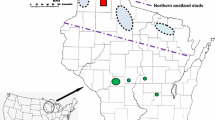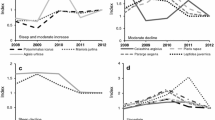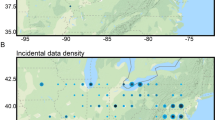Abstract.
A strong relationship between appearance dates and temperature has been demonstrated over two decades for most British butterflies. Given this relationship over time, this paper tests whether comparable spatial trends in timing are also apparent. A major survey of British butterflies is used to calculate mean sighting dates of adults across the country, and these are compared with geographic patterns in temperature. With the use of regression techniques, we calculated latitudinal (south–north) and longitudinal (east–west) gradients in sighting date and temperature. The majority of butterflies appear later in the east of Britain where temperatures are lower during summer, but not the rest of the year. Most butterflies are also seen later in the cooler north of the country, by upto 3–4 days/100 km. However, no geographical relationship between temperature and timing of appearance was detected for over a third of the species analysed, suggesting their populations may be adapted to their local climates. We suggest possible mechanisms for this and discuss the implications of such adaptation for the ability of butterfly species to respond to rapid climate warming.

Similar content being viewed by others
References
Abu-asab MS, Peterson PM, Shetler SG, Orli SS (2001) Earlier plant flowering in spring as a response to global warming in the Washington, DC, area. Biodivers Conserv 10:597–612
Asher J, Warren M, Fox R, Harding P, Jeffcoate G, Jeffcoate S (2001) The millennium atlas of butterflies in Britain and Ireland. Oxford University Press, Oxford
Ayres MP, Scriber JM (1994) Local adaptation to regional climates in Papilio canadensis (Lepidoptera, Papilionidae). Ecol Monogr 64:465–482
Bourn NAD, Thomas JA (2002) The challenge of conserving butterflies at range margins in Europe. Biol Conserv 104:285–292
Bradley NL, Leopold AC, Ross J, Heffaker W (1999) Phenological changes reflect climate change in Wisconsin. Proc Natl Acad Sci USA 96:9701–9704
Brakefield PM (1987) Geographical variability in, and temperature effects on, the phenology of Maniola jurtina (Lepidoptera, Satyridae) in England and Wales. Ecol Ent 12:139–148
Buse A, Good JE (1996) Synchronization of larvae emergence is winter moth (Operophtera brumata L.) and budburst in pedunculate oak (Quercus robur L.) under simulated climate change. Ecol Entomol 21:335–343
Conover DO, Present TMC (1990) Countergradient variation in growth rate: compensation for length of the growing season among Atlantic silversides from different latitudes. Oecologia 83:316–324
Conover DO, Schultz ET (1995) Phenotypic similarity and the evolutionary significance of countergradient variation. Trends Ecol Evol 10:248–252
Crick HQP, Sparks TH (1999) Climate change related to egg-laying trends. Nature 399:423–424
Gutiérrez D, Menéndez R (1998) Phenology of butterflies along an altitudinal gradient in northern Spain. J Zool 244:249–264
Hill JK, Thomas CD, Huntley B (1999) Climate and habitat availability determine 20th century changes in a butterfly's range margin. Proc R Soc Lond [Biol] 266:1197–1206
Hughes L (2000) Biological consequences of global warming: is the signal already apparent. Trends Ecol Evol 15:56–61
Hulme M, Jenkins G (1998) Climate change scenarios for the United Kingdom: summary report. Climate Research Unit, Norwich
Menzel A, Fabian P (1999) Growing season extended in Europe. Nature 397:659
Nylin S, Gotthard K (1998) Plasticity in life-history traits. Annu Rev Entomol 43:63–83
Nylin S, Svard L (1991) Latitudinal patterns in the size of European butterflies. Holarct Ecol 14:192–202
Peñuelas J, Filella I (2001) Responses to a warming world. Science 294:793–795
Pollard E (1991) Changes in the flight period of the Hedge Brown butterfly Pyronia tithonus during range expansion. J Anim Ecol 60:737–748
Roy DB, Sparks TH (2000) Phenology of British butterflies and climate change. Global Change Biol 6:407–416
Roy DB, Rothery P, Moss D, Pollard E, Thomas JA (2001) Butterfly numbers and weather: predicting historical trends in abundance and the future effects of climate change. J Anim Ecol 70:201–217
Schultz ET, Reynolds KE, Conover DO (1996) Countergradient variation in growth among new hatched Fundulus heterclitus: geographical differences revealed by common-environment experiments. Funct Ecol 10:366–374
Sparks TH (1999) Phenology and the changing pattern of bird migration in Britain. Int J Biometerol 42:134–138
Thomas JA (1991) Rare species conservation: case studies of European butterflies. In: Spellerberg IF, Goldsmith FB, Morris MG (eds) The scientific management of temperate communities for conservation. Blackwell, Oxford, pp 149–197
Thomas JA (1993) Holocene climate changes and warm man-made refugia may explain why a 6th of British butterflies possess unnatural early-successional habitats. Ecography 16:278–284
Thomas JA, Rose RJ, Clarke RT, Thomas CD, Webb NR (1999) Intraspecific variation in habitat availability among ectothermic animals near their climatic limits and their centres of range. Funct Ecol 13:55–64
Visser ME, Noordwijk AJ van, Tinbergen JM, Lessells CM (1998) Warmer springs lead to mistimed reproduction in great tits (Parus major). Proc R Soc Lond [Biol] 265:1867–1870
Walther G-R, Post E, Convey P, Menzel A, Parmesan C, Beebee TJC, Fromentin J-M, Guldberg OH, Bairlein F (2002) Ecological responses to recent climate change. Nature 416:389–395
Warren MS (1992) Butterfly populations. In: Dennis RLH (ed) The Ecology of butterflies in Britain. Oxford Science Publications, Oxford, pp 354
Warren MS, Hill JK, Thomas JA, Asher J, Fox R, Huntley B, Roy DB, Telfer MG, Jeffcoate S, Harding P, Jeffcoate G, Willis SG, Greatorex-Davies JN, Moss D, Thomas CD (2001) Rapid responses of British butterflies to opposing forces of climate and habitat change. Nature 414:65–69
Weiss SB, Murphy DD, White RR (1988) Sun, slope and butterflies: topographic determinants of habitat quality for Euphydryas editha. Ecology 69:1486–1496
Wickman PO, Wiklund C, Karlsson B (1990) Comparative phenology of four satyrine butterflies inhabiting dry grasslands in Sweden. Holarct Ecol 13:238–246
Zhou XL, Harrington R, Woiwod IP, Perry JN, Bale JS, Clark SJ (1995) Effects of Temperature on Aphid Phenology. Global Change Biol 1:303–313
Acknowledgements.
We are indebted to the dedicated recorders who submitted records to the Butterfly for the New Millenium project and made this work possible. We thank Tim Sparks for helpful discussions and Arnold van Vliet and the European phenology network (EPN) for the opportunity to present this work. D.R. received funding from the CEH Integrating fund (round 7).
Author information
Authors and Affiliations
Corresponding author
Additional information
Prepared in conjection with the International Conference "The times they are a changin". Climate change, phenological responses and their consequences for biodiversity, agriculture, forestry, and human health, held in Wageningen, The Netherlands, 5–7 Dec 2001
Rights and permissions
About this article
Cite this article
Roy, D.B., Asher, J. Spatial trends in the sighting dates of British butterflies. Int J Biometeorol 47, 188–192 (2003). https://doi.org/10.1007/s00484-003-0170-6
Received:
Accepted:
Published:
Issue Date:
DOI: https://doi.org/10.1007/s00484-003-0170-6




